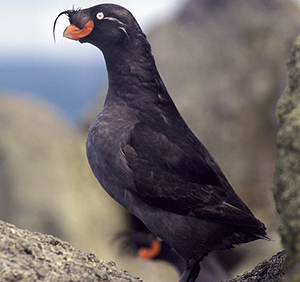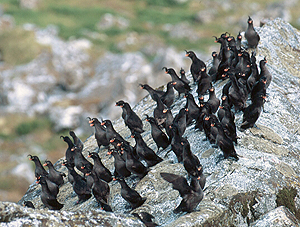Auklets' citrus odor fluctuates with season, hormones
Auklets’ citrus odor fluctuates with season, hormones
Submitted by Marmian Grimes
Phone: 907-474-7902
07/23/08



For crested auklets, the springtime surge in hormones brings the sweet smell of amore.
The small black and grey seabirds rub a citrus-like scent on each other during courtship, a behavior called alloanointing. Two researchers at the University of Alaska Fairbanks recently tied the strength of the scent to hormone levels in the birds’ bloodstreams.
"The significance of our findings is that floral odors in birds may be regulated by hormones, similar to what has been shown for pheromones in other vertebrates," said Hector Douglas, a marine biologist at the Kuskokwim Campus in Bethel.
Douglas’ research partner, Alexander Kitaysky, is a physiologist at the UAF Institute of Arctic Biology. The team’s findings are featured in the July edition of Hormones and Behavior, a scientific journal.
Douglas and his team traveled to the Shumagin Islands south of the Alaska Peninsula during the summer of 2002 to study the birds, which nest in huge colonies on remote island cliffs in Alaska and Siberia. The team captured auklets and then used a custom-designed collection system to measure the level of octanal--a citrus-like chemical--each bird emitted. Researchers also took blood samples from each bird. They then compared the sets of data and determined that the levels of octanal the birds emitted varied with progesterone levels in the birds’ blood.
"Steroid hormones coordinate and facilitate most of the physiological and behavioral changes associated with breeding. In the case of the crested auklet, we suspect that this may involve a biochemical change that occurs in spring," Douglas said. "Our findings are the first step in investigating how odor production is regulated."
Douglas’ auklet research formerly determined that the auklets’ citrus-like scent has dual purposes. In addition to playing a role in mating behavior, it also helps protect the birds from parasites such as ticks.
Funding for the research was provided by the Eppley Foundation for Research Inc., Angus Gavin Memorial Bird Research Fund through the University of Alaska Foundation and the John Wingfield Laboratory at the University of Washington.
CONTACT: Hector Douglas, assistant professor of biology, at 907-543-4589 or via e-mail at hddouglas@yahoo.com. Marmian Grimes, UAF public information officer, at 907-474-7902 or via e-mail at marmian.grimes@uaf.edu.


